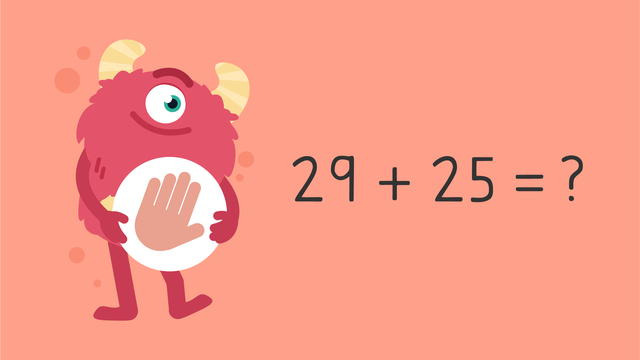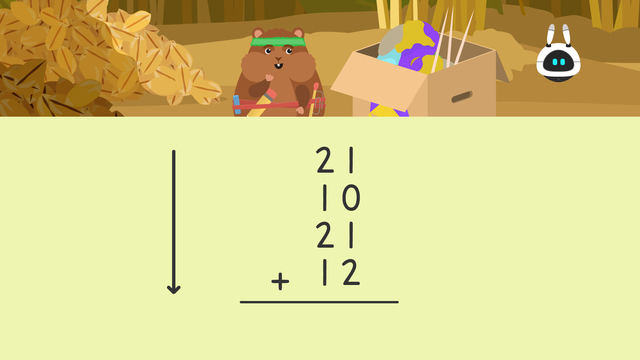Compensation in Addition
Basics on the topic Compensation in Addition
Compensation in Addition
Addition can quickly become confusing. Especially if the addends in the ones place add to a number higher than ten. But there is a strategy that you can follow to make complicated addition operations easier: It’s called compensation.
In this learning text you can learn about compensation with addition. Take a look below to learn more about the compensation addition strategy.
Compensation Strategy – Definition
What is compensation? And, how do you use compensation in addition? Let’s look at the definition for the compensation strategy:
Compensation is something given in return for something. In math, we use compensation with numbers. This can be a helpful strategy because it makes the numbers friendlier, or easier to add. However, when using addition compensation with manipulatives, always make sure that whatever you add or subtract to one side, you do the opposite to the other.
Using Compensation to Add
When using compensation in addition, you should follow these steps:
| Step # | What to do |
|---|---|
| 1 | Choose which addend to make friendlier, or easier to add. You can do this by looking for a zero or five in the ones place. |
| 2 | Make sure whatever you do to one addend, you do the opposite to the other. |
| 3 | Create a new equation using the friendlier, or easier addends. |
| 4 | Solve the equation! |
Compensation Math Addition – Example
In this example we are adding nuts and bolts to find out how many materials we have. How can we use the compensation strategy to add his thirty-two nuts and eight bolts?
| nuts | bolts |
|---|---|
| 32 | 8 |
| addend 1 (nuts) | addend 2 (bolts) | |
|---|---|---|
| compensation | 32 (+3) | 8 (-3) |
| new equation | 35 | 5 |
We can use compensation to make the new equation, thirty-five plus five which equals forty. Mr. Squeaks has forty materials to work with!
Addition with Compensation 2nd Grade – Summary
Remember, when using compensation in addition, you should follow these steps:
Step one: choose which addend to make friendlier, or easier to add. You can do this by looking for a zero or five in the ones place.
Step two: make sure whatever you do to one addend, you do the opposite to the other.
Step three: create a new equation using the friendlier, or easier addends.
Step four: solve the new equation!
Looking for extra practice with compensation in addition? After this video check out the interactive exercises and compensation addition worksheet.
Transcript Compensation in Addition
: "I found it, the map to the giant waterfall!" : "If we follow these directions and add all the steps, we can find it again." : "We need to take twenty-five steps past the tree and six more to find the cave." Let's learn about compensation in Addition to help Mr. Squeaks and Imani. There are many different strategies and tools to add. One is compensation, something given in return for something, in math we use this with numbers. This can be a helpful strategy to add or subtract because it makes the numbers easier to add. BUT! Whatever is done to one addend, the opposite is done to the other. That means if we add to one addend, we must subtract the SAME amount from the other addend. Mr. Squeaks and Imani need to add twenty-five plus six. When using compensation, first choose which number to make friendlier, or easier to add. You might choose these numbers by looking for a zero or five in the ones place. Here we can add five (...) to twenty-five to make it thirty. Since we added five to twenty-five, we MUST subtract it from six. What is six minus five? (...) one. Next, create a new equation using the new addends. Our new equation is thirty plus one. Finally, solve the new equation now that it is easier to add. Here we can count on one in our heads to get our sum, or answer, thirty-one! That means that twenty-five plus six ALSO equals thirty-one. : "Ahh, I've missed this cave." : "Next we need to skip thirty-two times and then eight more to find the secret tunnel inside the cave." How can we use compensation to help our friends find the secret tunnel? First choose which addend to make friendlier, or easier to add. We can add three (...) to thirty-two to make it thirty-five. Since we added three to thirty-two, we MUST subtract three from eight. What is eight minus three? (...) five! Next, create a new equation using the new addends. Our new equation is thirty-five plus five. Finally, solve the new equation now that it is easier to add. What is thirty-five plus five? (...) forty! That means that thirty-two plus eight ALSO equals forty. "It's a tighter squeeze this time!" : "Oh, thanks, Imani!" "We're so close! We just need to run past forty-three rocks and then nine more to find the giant waterfall!" Let's use compensation one more time! First choose which addend to make friendlier. We can add one to the nine to make it ten. We added one to the nine, so we MUST subtract one from forty-three. Forty-three minus one is forty-two. Next, create a new equation with the new addends. Our new equation is forty-two plus ten. Finally, solve the new equation now that it is easier to add. What is forty-two plus ten? (...) fifty-two! Which means that forty-three plus nine is ALSO fifty-two. Before we see the magical waterfall, remember! When using compensation in addition... First choose which addend to make friendlier. You can do this by looking for a zero or five in the ones place. Whatever you do to one addend, the OPPOSITE must be done to the other. Next, create a new equation using the new addends. Finally, solve the new equation using mental math now that it is easier to add. Now, let's see that waterfall! : "We made it, Imani!" : "Look at that, it's amazing!"
Compensation in Addition exercise
-
Identify the equation using the new addends.
HintsRemember, Imani is subtracting 2 from the number 22. He is adding 2 to the number 5.
Think about the new equation. It will be (22 - 2) plus (5 + 2).
SolutionNow that Imani has used compensation, their new equation is 20 + 7.
They subtracted 2 from 22 to get 20, and added 2 to 5 to get 7.
Now they can add the numbers more easily to make 27!
-
Show the steps.
HintsRemember, compensation in math means something is given in return for something else.
If one number is added to a digit, the same number must be subtracted from the second digit.
Look at this example. When adding 25 + 6, we can make 25 more friendly. We can turn 25 into 30 by adding +5, which means we have to subtract -5 from the other addend, 6. The new equation is 30 + 1.
SolutionMr. Squeaks used compensation to make 36 into a friendly number, 40. He added +4 to 36 (36 + 4 = 40), so he had to subtract -4 from 4 (4 - 4 = 0). The new equation is 40 + 0, which we can solve.
40 + 0 = 40.
-
Which shows compensation?
HintsRemember, when using compensation, whatever is added to one addend needs to be subtracted from the other.
SolutionSince Imani is using compensation, they want to make friendly numbers. They see 32, and subtract -2 to create 30. Since -2 was subtracted from one addend, it needs to be added to the other addend, 8. 8 plus +2 creates 10.
The new equation is : 30 + 10, which Imani can use to solve more easily. 30 + 10 = 40
-
What are the steps taken when using compensation?
HintsThe first step for using compensation is to choose which number to make friendlier.
Once you make one number friendly, you will need to decide which number to subtract from one and add to the other.
Remember, when we say which number is friendlier, we mean which number is easiest to add to.
For example, in 15 + 7, you would choose to add 5 to 15 to make it a friendly 20. From there, you would need to subtract 5 from 7 to even the equation.
SolutionThese are the steps used in compensation.
For example, look at 25 + 8.
Step 1: Choose which number to make friendlier. Since 25 ends in a 5, I can add 5 to make it a friendly 30.
Step 2: Add the amount chosen to one number, and subtract the amount chosen from the other. In this example, we add 5 to 25 to make 30 (25 + 5 = 30), and subtract 5 from 8 to make 3 (8 - 5 = 3).
Step 3: Create a new equation using the new addends. The new equation is: 30 + 3
Step 4: Solve the new equation: 30 + 3 = 33
-
Identify the correct answer.
HintsRemember, when finding a friendly number, we look at the ones place.
SolutionNumbers that have a zero or five in the ones place are friendly numbers, since many numbers can be easily added to 0 and 5.
-
Solve the equations.
HintsWhen using compensation, remember to make one number a friendly number first.
Compensation means something is given in return for something else. For example:
24 + 7 = ?
We can make 24 more friendly by adding +6 to make 30. Now, because we added 6 to one number, we must subtract 6 from the other. 7 - 6 makes 1.
The new equation is: 30 + 1.
30 + 1 = 31.
SolutionYou may have solved these problems the same or differently, there are multiple ways to use compensation.
45 + 7 = 52.
We can make 7 a friendly number by adding +3 to make 10. Now, because we added 3 to one number, we must subtract 3 from the other number, 45. 45 -3 makes 42.
The new equation is: 42 + 10.
We add this new equation more easily to solve the problem: 42 + 10 = 52.
12 + 8 = 20.
We can make the 12 into a friendly 10 by subtracting 2 (12 - 2 = 10). Since we subtracted 2 from one number, we must add 2 to the other (8 + 2 = 10).
The new equation is: 10 + 10.
We use this new equation to solve: 10 + 10 = 20.
7 + 6 = 13
We can make 7 more friendly by adding +3 to make 10. Now, because we added 3 to one number, we must subtract 3 from the other number, 6. 6 - 3 makes 3.
The new equation is 10 + 3.
10 + 3 = 13

Order in Adding

Using Make Ten to Add

Compensation in Addition

Compensation in Addition — Let's Practice!

Subtract Using Addition — Let's Practice!

Make a Number Line to Add — Let's Practice!

Adding Four Two Digit Numbers

Using Place Value to Subtract (Regrouping)

Using Place Value to Add Two Digit Numbers (No Regouping)











